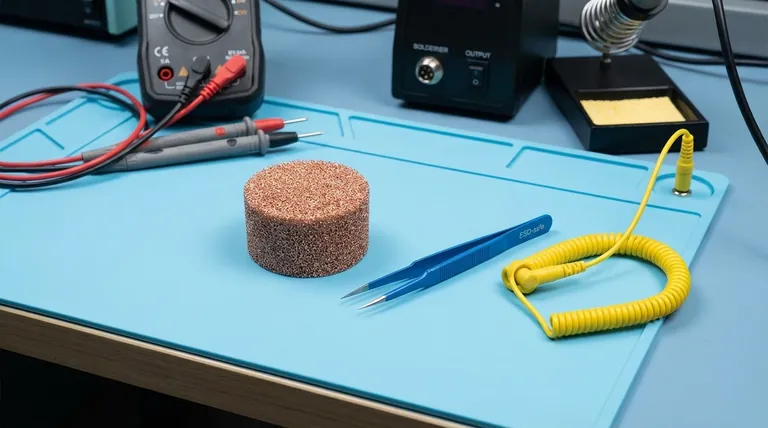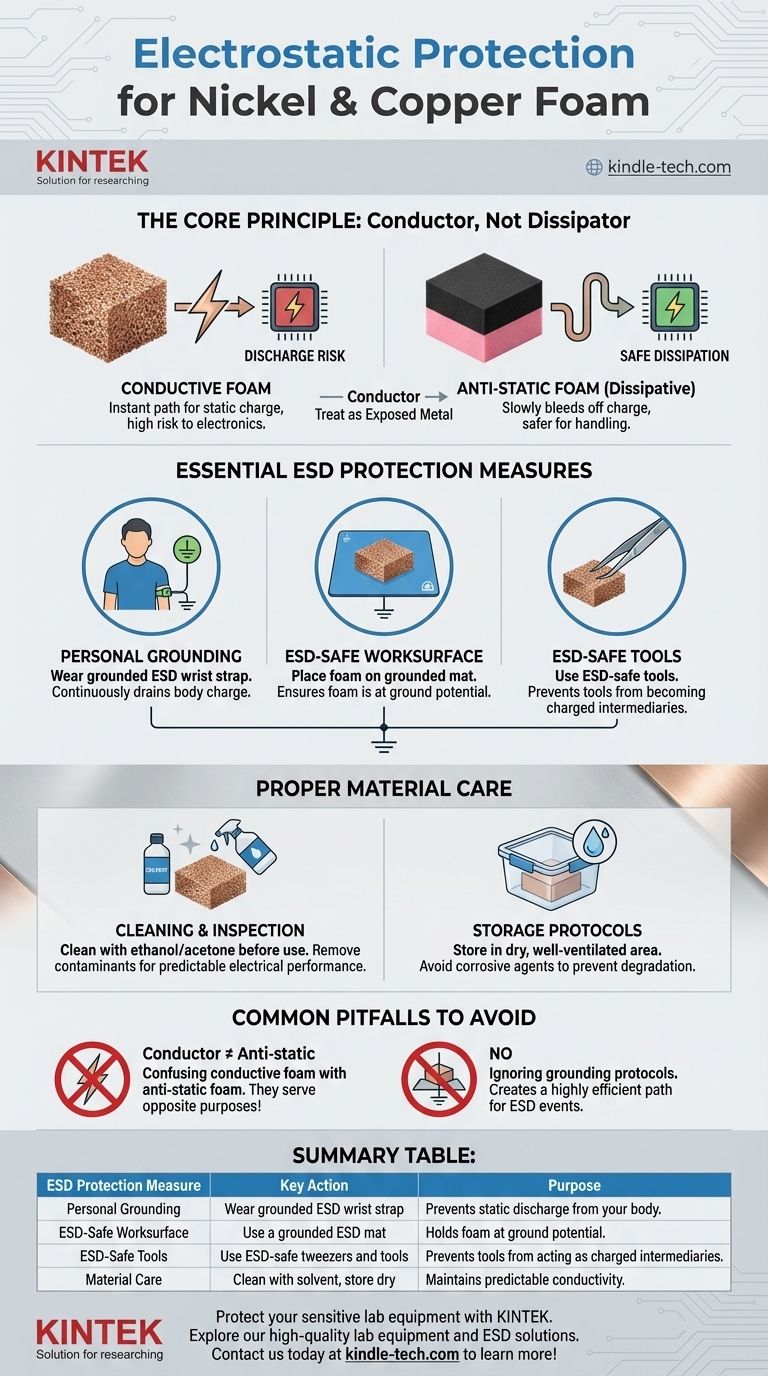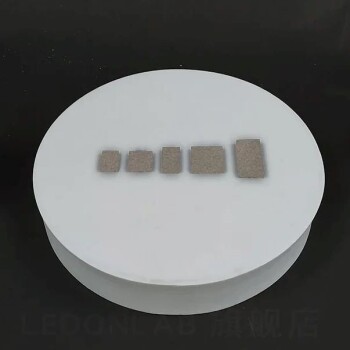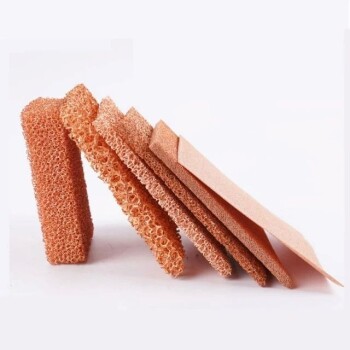The short answer is that because nickel and copper foams are excellent electrical conductors, you must treat them as you would any exposed metal component in an electrostatically sensitive environment. This requires implementing standard Electrostatic Discharge (ESD) safety protocols, primarily focused on grounding yourself and your worksurface to prevent any static potential from discharging through the foam into sensitive devices.
The core principle is not to treat the foam as a source of static, but as a highly efficient path for it. Your primary goal is to ensure that you, the foam, and any sensitive components are all at the same electrical potential (ideally, ground) before they come into contact.

The Principle: Why a Conductor is an ESD Risk
Standard anti-static foams (often pink or black) are designed to be dissipative, meaning they slowly and safely bleed off static charges. Nickel and copper foams are fundamentally different.
It's a Conductor, Not a Dissipator
These metal foams have very low electrical resistance. This means they will not slowly dissipate a charge; they will conduct it almost instantly, much like a wire.
The Human Body Problem
The human body can easily accumulate thousands of volts of static electricity through simple actions like walking on a carpet. If you, while charged, touch a piece of copper foam that is also in contact with a sensitive electronic component, your body's entire static charge can discharge instantly through the foam and destroy the component.
Essential Electrostatic Protection Measures
To handle these materials safely, you must create an Electrostatic Protected Area (EPA). This involves a system of components all connected to a common ground point.
Use Personal Grounding
This is the most critical step. Always wear a properly tested ESD wrist strap that is connected to a common point ground. This continuously drains any static charge from your body, preventing you from ever creating a discharge event.
Utilize an ESD-Safe Worksurface
Place the metal foam on a grounded ESD mat. This ensures the foam itself is held at ground potential. If you (grounded via a wrist strap) then touch the foam (grounded via the mat), there is no difference in electrical potential and no discharge can occur.
Handle with ESD-Safe Tools
If you are using tweezers or other tools to manipulate the foam, ensure they are also ESD-safe. This prevents the tool from becoming a charged intermediary between you and the foam.
Proper Material Care for Predictable Performance
The general handling advice for these foams is not about ESD protection directly, but about maintaining their predictable conductive properties, which is critical for their function.
Pre-Use Inspection and Cleaning
Before use, inspect the foam for damage and clean it with a solvent like ethanol or acetone. Contaminants like oils or oxides can create insulating layers, leading to unpredictable electrical performance.
Post-Use Assessment
After use, clean any residues from the foam. Testing its conductivity ensures it has not been compromised and is safe and effective for its next application.
Correct Storage
Store the foam in a dry, well-ventilated environment away from corrosive agents like strong acids or alkalis. Corrosion will degrade the metal and alter its conductivity, making its behavior unreliable.
Common Pitfalls to Avoid
The biggest mistake is confusing conductive foam with anti-static foam. They serve opposite purposes and must be handled differently.
Misunderstanding its Role
Never place ungrounded electronics on a piece of metal foam as a form of "protection." Without a shared ground, the foam simply becomes a larger, more complex conductor that can bridge and short-circuit components.
Ignoring Grounding Protocols
Using metal foam in a sensitive environment without grounding yourself and your worksurface is often more dangerous than using no foam at all. You are introducing a highly efficient conductor for ESD events.
Making the Right Choice for Your Application
Your handling procedure depends entirely on the context of your work.
- If your primary focus is protecting sensitive electronics: You must use a complete ESD-safe workstation, including a wrist strap and a grounded mat. Grounding is non-negotiable.
- If your primary focus is mechanical, thermal, or chemical applications: While ESD is less of a concern, the cleaning and storage protocols are vital to preserve the foam's structural integrity and prevent contamination.
Ultimately, treating nickel and copper foam with the same respect as an exposed circuit board is the key to preventing damage.
Summary Table:
| ESD Protection Measure | Key Action | Purpose |
|---|---|---|
| Personal Grounding | Wear a grounded ESD wrist strap | Prevents static discharge from your body to the foam |
| ESD-Safe Worksurface | Use a grounded ESD mat | Holds the foam at ground potential to avoid potential differences |
| ESD-Safe Tools | Use ESD-safe tweezers and tools | Prevents tools from acting as charged intermediaries |
| Material Care | Clean with ethanol/acetone; store in dry, ventilated areas | Maintains predictable conductivity and prevents contamination |
Protect your sensitive lab equipment with the right ESD protocols. KINTEK specializes in providing high-quality lab equipment and consumables, including ESD-safe tools and materials, to ensure your laboratory operates safely and efficiently. Our expertise helps you maintain the integrity of your conductive materials like nickel and copper foam, preventing costly damage to sensitive components. Contact us today to learn more about our ESD solutions and how we can support your laboratory needs!
Visual Guide

Related Products
- Copper Nickel Foam Metal Sheet
- Copper Foam
- High Purity Zinc Foil for Battery Lab Applications
- Aluminum Foil Current Collector for Lithium Battery
- Electron Beam Evaporation Coating Conductive Boron Nitride Crucible BN Crucible
People Also Ask
- What are the typical uses for carbon paper? Powering Fuel Cells and Advanced Research
- What are the advantages disadvantages and uses of sheet metal? The Ultimate Guide to Material Selection
- What are the characteristics of copper foam? Unlock High-Performance Thermal and Electrical Solutions
- What is the porosity of an RVC glassy carbon sheet? Understanding the Critical Difference Between PPI and Porosity
- What regular maintenance is required for an RVC sheet? A Guide to Preserving Electrode Performance



















